Peristereon (Vervain) and Brionia (Black Bryony).
Nimphea (Water-lily) and Chrision (Red Clover).
Nimphea (Water-lily) and Chrision (Red Clover).

Salvia (Sage), Coriandrum (Coriander) and Portulaca (Purslane).
Cerefolium (chervil), Sisimbrium (Water Mint),
Oleastrum (Alexanders), Lilium (Lily) and Tytimallum (Spurge).
Cerefolium (chervil), Sisimbrium (Water Mint),
Oleastrum (Alexanders), Lilium (Lily) and Tytimallum (Spurge).

Senecion (Groundsel) and Filix (Asplenium). Gramen
(Ttwitch Grass), Gladiolus (Flag) and Rosmarinus (Rosemary).
(Ttwitch Grass), Gladiolus (Flag) and Rosmarinus (Rosemary).

Silvaticum (Sonchus), Lupinum (lupin), Lacterideum (Daphne gnidium)
and Lactuca leporica (Lettuce). Scicideagria (Cucumber),
Canapus silvaticus (Hemp) and Ruta montana (Ruta montana).
and Lactuca leporica (Lettuce). Scicideagria (Cucumber),
Canapus silvaticus (Hemp) and Ruta montana (Ruta montana).
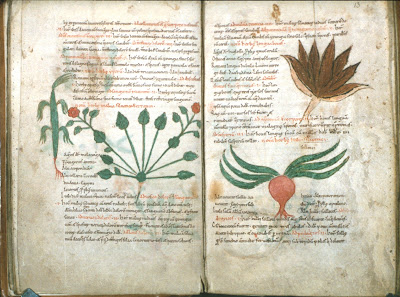
Yperum (Horsetail) and Malva sivatica terratica
(Malva sylvestris). Lingua bovis (Bugloss) and Scillitici (Squill).
(Malva sylvestris). Lingua bovis (Bugloss) and Scillitici (Squill).

Mandragora (Male Mandrake) Book of Extracts from Dioscorides.

Mandragora (Female Mandrake).

Muoluta (House Leek), Eliotropion and Grias (Madder).
Pollitricum (Hop Trefoil), Astula regia (Woodruff) and Splenion (Hartstongue).
Pollitricum (Hop Trefoil), Astula regia (Woodruff) and Splenion (Hartstongue).

Papaveris silvatici (Opium Poppy) and Ynantes (Dropwort).
Narcissos (Narcissus poeticus) and Polion (Teucrium Polium).
Narcissos (Narcissus poeticus) and Polion (Teucrium Polium).
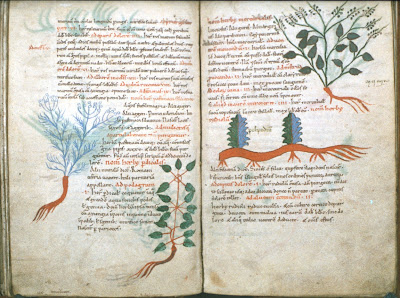
Pastinaca (Carrot) and Pericalis (Pellitory).
Mercurialis (Cheadle) and Radiolus (Everfern).
Mercurialis (Cheadle) and Radiolus (Everfern).

Achillea (Yarrow) and Ruta hortensis (Rue).
Mentastrum (Horse-mint) and Ebulum (Danewort).
Mentastrum (Horse-mint) and Ebulum (Danewort).
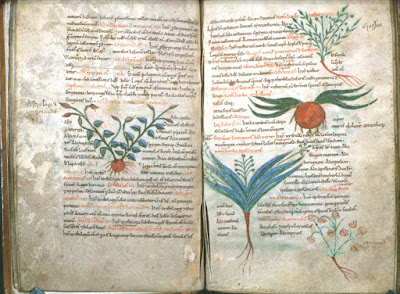
Aristologie rotundae (Smearwort). Nasturcium, Eribuluus,
Apollinaris (Glovewort) and Chamomelum (Chamomile).
Apollinaris (Glovewort) and Chamomelum (Chamomile).

Diptannum (Dittany) and Solago maior (Heliotropium europaeum).
Solago minor (African Marigold) and Peonia (Peony).
Solago minor (African Marigold) and Peonia (Peony).

Eptafillos, Ocimum (Wild Basil) and Appium (Apium). Crosocantis (Ivy),
Menta (Cornmint), Anetum (Dill), Origanum (Marjoram) and Semperviva.
Menta (Cornmint), Anetum (Dill), Origanum (Marjoram) and Semperviva.

Feniculum (Purplered), Erisifion and Simphitum.
Petrosilinum (Parsley), Silvatica and Basilisca.
Petrosilinum (Parsley), Silvatica and Basilisca.
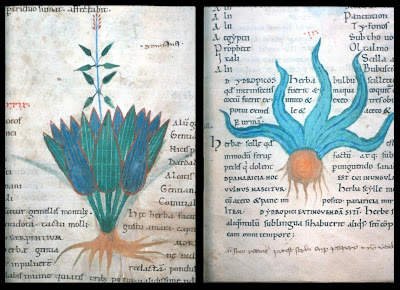
Autumn Gentian and Squill

Narcissus poeticus and Yarrow
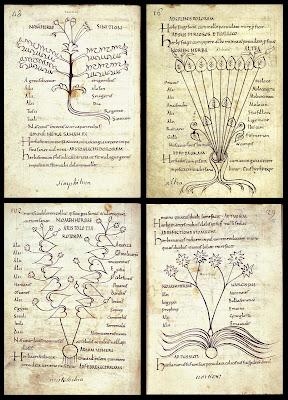
Herba senecion; Herba altea - hibiscus (heemst);
Herba aristolochia rotunda (pijpbloem); Herba narcissus
Herba aristolochia rotunda (pijpbloem); Herba narcissus
Herbals are a particularly interesting group in the history of written communication in that they have always been in circulation since the antiquities and were not 'rediscovered' during the renaissance.
Despite the faithful transcription of the manuscript text by monastic scribes, distortions inevitably crept in as the work passed from one hand to the next. Greater variation exists among the illustrations which were often painted without reference to the living world. Regional variation in both plant types and knowledge as well as differences in editorial control also contributed over a thousand years of copying to a body of herbal manuscripts deriving from a few ancient sources.
This all makes for a complex history but there are two lines or branches generally identified in classifying the lineage of a herbal. Perhaps the most important is the five volume pharmacopoeia/herbal, 'De Materia Medica' by Dioscorides from the first century AD, which represents the Greek/Arabic tradition. This work also supplies much of the textual origin for the other branch, the latin tradition - the subject of this post - which is contained within a corpus of works by an amalgamated author, referred to as Pseudo-Apuleius (sometimes called Apuleius Platonic, to distinguish him or them from a number of other authors from the middle ages called Apuleius). The original Pseudo-Apuleius Herbal was produced in about the 5th century AD.
The illustrations seen above are thought to derive from unknown manuscripts from the antiquities. As best I can tell, there are about four or five extant copies of the Pseudo-Apuleius Herbal of particular importance.
The last image above includes four drawings from a 10th century work; the two preceding images come from a manuscript of collected works from the late 11th century that includes extracts from the Pseudo-Apuleius Herbal; and all the rest of the images are from a complete manuscript, produced in about 1080. Additionally, there is a 9th century version in the Abbey of Monte Cassino (Codex casinensis 97) which doesn't appear to be online but was published in book form together with a facsimile of the first printed version of the Herbal from 1481. I also saw mention of a 6th or 7th century manuscript still in existence but I couldn't track it down.
Oxford University scanned existing filmstrips and slides to produce digitized versions of these manuscripts so the quality is not up to the usual standards of modern photography. Nevertheless, the reason these works grabbed my initial attention was because of the vividness and range of the colours. A thousand years old and they still appear bright and arresting. I think that's just amazing.
- MS. Ashmolean 1431 Pseudo-Apuleius, Herbal England, St. Augustine's Abbey, Canterbury; 11th century, c. 1070-1100 (thumbnail page).
- MS. Bodleian. 130 Pseudo-Apuleius, Dioscorides, Herbals (extracts); De virtutibus bestiarum in arte medicinae, in Latin and English England, Bury St. Edmunds; late 11th century (thumbnail page).
- The Aboca Museum have a number of example pages (photocopy quality) from the 1481 printed version of the Herbal - there is a page of background commentary.
- Den Haag, MMW, 10 D 7 is the 10th century version (also still in remarkably good condition) among the Meermanno collection in Holland (thumbnail page).
- It's really difficult to recommend any other links: I basically saw snippets of information in dozens of websites but none of it was particularly useful on its own. Minta Collins, an art historian, released a book in 2000 called 'Medieval Herbals: The Illustrative Tradition' [University of Toronto Press] which is touted as a new leading authority on the exegesis of the Herbal manuscript traditions: {Folklore Society review; scathing Smithsonian academic's review; Botanist's review}. I can't decide whether I want to read it or not.
---------
I've changed over to the new blogger, simply to stop it asking me to do so. It was rather painless. Sorry if there were a whole bunch of feed entries blurted out at the same time. I don't think I'll bother with the tags - to my mind they are pretty useless for this site without some summary and as both tags and summaries are already at del.icio.us, blogger tagging is an unnecessary redundancy isn't it? So far the only real difference I've noticed is that uploading images seems to take longer. Oy.




















6 comments :
great stuff,as usual !
are you familiar with the voynich manuscript ?
It does look like the voynich, doesn't it? Add in some astrology ..but the plants look similiar, or perhaps copied.
Do you know where there is a text copy of the book? I can handle the Latin but I can't READ that. :) If you do, could you email me - I've been looking for a while skullaria at gmail dot com thanks
The only two links I could think of to start the search are Amazon (it's a more narrow results set using the google) and Worldcat. Good luck!
Got any more carrot illustrations? - for the World Carrot Museum. OR places where I might find some?
Thanks, John
Um.. well one presumes you have done some searching already. I wouldn't want to regurgitate ideas already followed. Obviously hitting up all the galleries, libraries and suchlike repositories online with that term 'carrot' is the way to go. I predict you will get enormous numbers. If you want to get more specific about it, email me: peacay --> gmail.
Post a Comment
Comments are all moderated so don't waste your time spamming: they will never show up.
If you include ANY links that aren't pertinent to the blog post or discussion they will be deleted and a rash will break out in your underwear.
Also: please play the ball and not the person.
Note: only a member of this blog may post a comment.